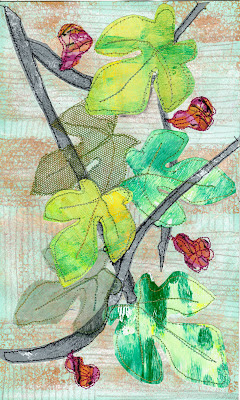I went to the "Sewing for Pleasure/Fashion, Embroidery & Stitch/Hobby Crafts" show on Thursday. I have been up to Birmingham NEC by train a couple of times before with friends, but this time I went on my own. I was disproportionately anxious about catching the right train before I went, goodness know why, but of course everything went smoothy. I was at Milton Keynes station a good half an hour before my train was due, and it was blowing a freezing gale along the platform.
I only gave the Hobby Craft section a quick walk through as I was more interested in the other areas. I did take my little camera, but of course didn't use it very much. What I was here for was supplies I couldn't easily get locally and of course an allowance for a few impulse purchases, no point in going unless you can indulge yourself a bit.
It is always enlightening visiting the exhibitors' stands rather than the suppliers, and there is always a lot to learn, although I am not very good at taking it all in. I made a bee line for the Kemshalls' stand which was beautifully laid out. It was great to see so many of the quilts and cushions from their web site in real life. I also bought one of their packs of Madeira Lana thread, which I have never seen in a shop.
Bobby Britnell was busy demonstrating on the At Van Go stand. I gave than one a miss as I will be visiting the shop in a few weeks when I have a workshop with Ruth Issett, and a couple of weeks later another one with Bobby.
It is always great to bump into someone you know at these events and when I was photographing the Moor Threads stand, and this display of Bobby Britnell's work I realised that I had met Penny from the group at a AVG workshop.
I enjoyed all of this groups' work.
Other displays of interest were the Jane Austen costumes from a selection of TV and film adaptations of her books. I couldn't resist a snap of Colin Firth's famous shirt.

Unfortunately he wasn't modelling it!
I then had to snap Jennifer Ehle's dress as she was Mr T's favourite. Can't believe it was 1995 when this series of Pride and Prejudice was on TV.
So this is what I came home with...
some pretty space dyed fabrics, threads and felt...
...some printed tape, buttons and the Lana thread...
... and some stencils to use on my Gelli plate.
There were a few other bits and pieces - plain thread for dyeing and needles and so on. I know next week there will be something I wish I had got or a stand I had looked more closely at, but so it goes!
We woke to slushy snow this morning, so I am glad I chose to go to Birmingham on Thursday. Hope your weekend is not too bad and fingers crossed that spring will be here soon
Jill






















